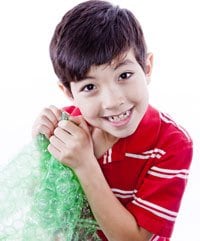Put away the bubble wrap
Stephen Leslie, MD
CentraCare Clinic – Health Plaza Allergy & Asthma
 You don’t have to put your child in a plastic bubble when you find out about his or her allergies. While it’s normal for parents to want to protect their child from harm, overreacting to their allergies is not the answer. You cannot shield them from every little thing that may cause them harm.
You don’t have to put your child in a plastic bubble when you find out about his or her allergies. While it’s normal for parents to want to protect their child from harm, overreacting to their allergies is not the answer. You cannot shield them from every little thing that may cause them harm.
With allergy season, it is key to know the difference between an allergy and a cold. They can present with very similar symptoms, but these differences can help you tell one from the other:
- Allergies do not cause a fever or body aches, unlike a cold or flu.
- Colds often produce nasal discharge that is greenish and thick, where as discharge from an allergy is clear and thin.
- Colds usually last seven to 10 days, while allergy symptoms last until an allergen is removed.
- Allergic reactions can cause a rash.
There are many different types of allergies. Here are the most common:
Food allergies
- Cow’s milk
- Peanuts
- Soybeans
- Eggs
- Wheat
Environmental allergies
Contact irritants and allergies
- Detergents
- Cosmetics
- Perfumes
- Cleaning supplies
- Certain plants
It is not advisable to diagnose allergies yourself. Confirm allergens through an allergy test, either from your health care provider or an allergist.
The problem with allergies is that once you have identified the source of an allergy, you may need to follow up with research because it may be necessary to avoid other things as well that are not noticeable to the naked eye. For example, if your child is allergic to milk, other ingredients to avoid are whey and casein. In this case, a parent may want to try a substitute for milk, such as coconut milk or rice milk. Make sure you confirm the allergy with a health care provider before making any decisions, and ask him or her to recommend alternative products to use.